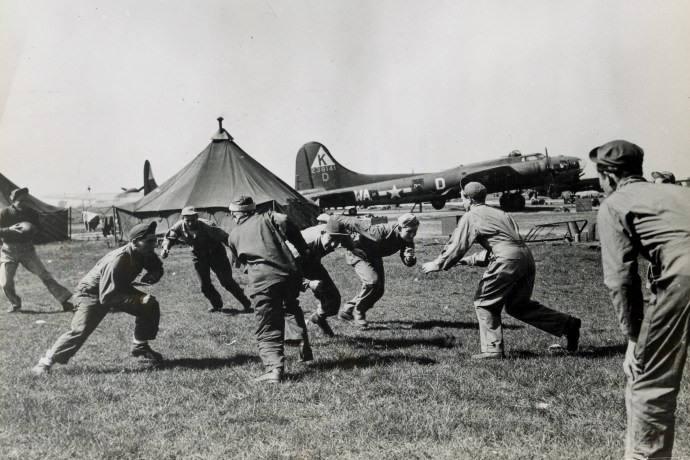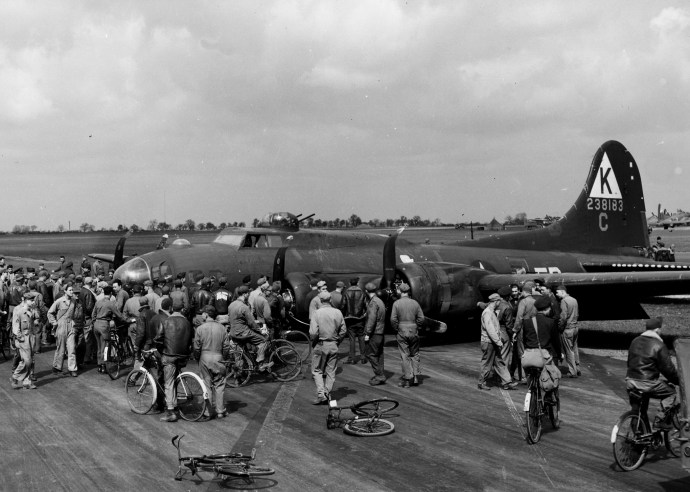 Over the years, I’ve come across interesting things American air crews have thrown out of their planes during bombing missions. One of the more famous was a donkey that was a B-17 group’s mascot. They’d picked the donkey up in North Africa and brought it back to England, where the local kids were given rides on it. The donkey kicked the bucket one day, so the guys in the bomb group somehow put it in an NCO’s uniform, gave it a set of dogtags and dropped it over Germany during their next mission. You know that somewhere, in some archive, is a report of finding a flattened, uniformed donkey in some poor German farmer’s field.
Over the years, I’ve come across interesting things American air crews have thrown out of their planes during bombing missions. One of the more famous was a donkey that was a B-17 group’s mascot. They’d picked the donkey up in North Africa and brought it back to England, where the local kids were given rides on it. The donkey kicked the bucket one day, so the guys in the bomb group somehow put it in an NCO’s uniform, gave it a set of dogtags and dropped it over Germany during their next mission. You know that somewhere, in some archive, is a report of finding a flattened, uniformed donkey in some poor German farmer’s field.
In 2010, while I was with TF Brawler at FOB Shank, Afghanistan, I was on a Chinook that was near-missed by an RPG as we were coming into land at COP Tangi. The village by the COP was pretty hostile, and aircraft often took fire getting into that outpost. I wanted to take pee-filled Gatorade bottles and drop them on that village the next time we had to get out to Tangi Valley. Unfortunately, the prudent Chinook company’s commander nixed that idea. Apparently, raining pee down on the populace doesn’t really lend itself to the whole hearts-and-minds thing. Still, it would have been good for morale.
Anyway, I was reminded of that suggestion today while reading through a Boeing tech rep’s report from the SWPA. He’d been hanging out with the 43rd Bomb Group “Ken’s Men” in Australia and New Guinea, and had written a report home on how the B-17’s were holding up in the tropics. The author of the report, R.L. Stith took detailed notes on what was one of the largest heavy bomber raids launched in the Pacific to date.
On February 13, 1943, the 43rd Bomb Group put aloft thirty-five B-17’s so heavily laden that Stith remarked, “How can one talk balance when they get away with this and worse?” The main force of thirty-three Forts carried sixteen three hundred pound demolition bombs that had been wrapped with wire to create more shrapnel when they detonated. Alongside those three hundred pounders, the ground crews stuffed the bays with sixty incendiary clusters each weighing twelve pounds. In the radio compartments of each plane, four twenty-two pound flares were stashed. And just forward of the waist guns, the Forts carried more than a dozen twenty pound fragmentation bombs. Somehow, another three hundred pounds of emergency gear was stashed throughout the fuselage of each aircraft as well.
The plan called for a night attack on Rabaul with the intent of setting parts of the town afire with the incendiary bombs. The main force would hit the target area sometime after 0300 on February 14th. Two other B-17’s had been assigned to go in ahead of the main force, and it was their load-out that got my attention.
The two B-17s were supposed to keep the Japanese awake and in their slit trenches for hours so that by the time the main effort reached Rabaul, they would be worn out and demoralized. To do this, Stith noted they had been loaded with a mix of incendiary clusters, fragmentation bombs–and beer bottles.
Americans. Piss us off, and we’ll rain our empties down upon you without remorse. Go us.
 I did a double take when I saw that in an official report. Beer bottles? They seriously dropped Coors Light on the Japanese at Rabual? Then it dawned on me: an empty bottle dropped from 6,000 feet has got to make the mother of all whistling sounds. That kept with the mission profile for those those B-17’s–keep the Japanese awake and in their trenches. The beer bottles were a cheap, field expedient noise maker that didn’t take up much space or weight and could be hurled out of the waist positions at the crew’s leisure. In a theater known for its innovation, this small one was nothing short of brilliant.
I did a double take when I saw that in an official report. Beer bottles? They seriously dropped Coors Light on the Japanese at Rabual? Then it dawned on me: an empty bottle dropped from 6,000 feet has got to make the mother of all whistling sounds. That kept with the mission profile for those those B-17’s–keep the Japanese awake and in their trenches. The beer bottles were a cheap, field expedient noise maker that didn’t take up much space or weight and could be hurled out of the waist positions at the crew’s leisure. In a theater known for its innovation, this small one was nothing short of brilliant.
That night, the first two Flying Forts reached Rabaul and began trolling back and forth over the target area. Searchlights speared the sky around them, anti-aircraft fire peppered the night’s sky, and the the American pilots changed the pitch on their propellers to maximize their noise signature. They gradually released their bombs. Between them, the beer bottles came shrieking down on the Japanese.
At 0340, main effort arrived in four waves, flying at altitudes ranging from four to nine thousand feet. Over the next several hours, the 43rd Bomb Group dropped sixty-nine tons of bombs on Rabaul, sparking a massive conflagration among known supply dumps around Rabaul, destroying searchlights, food stockpiles, oil tanks and grounded aircraft. The 3,700 incendiaries dropped on the target created a sea of fire a half mile long and a quarter mile wide. The flames were estimated to be two hundred feet tall, and the plume of smoke from the attack towered ten thousand feet over the target area. The conflagration could be seen from the air for a hundred miles.
Surviving Japanese documents describe the attack as a costly one and very damaging. Some fifteen aircraft were destroyed, as were ammunition dumps and other installations. Total casualties have been lost to history, but the Japanese sources mention a heavy loss of life.
There is no record of their response to the beer bottle barrage, but the attack (and another one the following night) clearly had an impact on the garrison’s morale. Bruce Gamble, in his outstanding work, Fortress Rabual, notes that one illness-plagued petty officer assigned to Air Group 705 later wrote, “I felt beaten physically and emotionally. I tossed and turned to ease the suffering, but the nightmares kept possessing me with no break.”
One has to wonder if he heard those beer bottles shrieking earthward in his nightmares.
What’s the most unusual thing you’ve heard about dropped during a bombing raid?














